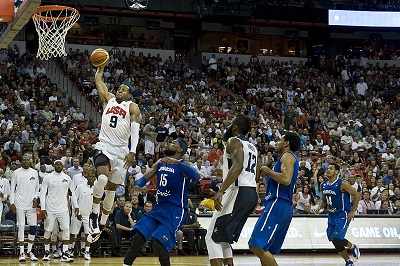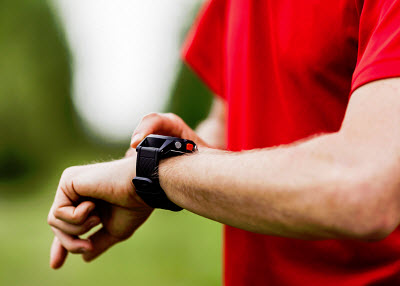The NBA Finals MVP has declared that wearables are exceptionally helpful to athletes.
Andre Iguodala has given tremendous praise to wearable technology when he recently spoke about the role that it played in the title win by the Golden State Warriors.
Wearables have been increasing in popularity among athletic teams and individual athletes, alike.
Iguodala spoke at a panel, recently, where he said that “The wearable market helps athletes more than anybody. You can say they helped us win a championship.” This is no small statement, as wearable technology was just credited with assisting the athletes to an actual championship win. Teams have been using these mobile devices at a growing rate to not only better understand the performance of the players, but also to help them to reduce the risk of injury.
The NBA player also recently visited the headquarters of Jawbone in San Francisco for more wearable technology.
 While there, he met with Hosain Rahman, the CEO of Jawbone. This allowed him to share the personal sleep data that had been collected by Iguodala’s UP activity tracker and the related mobile application. An analysis was conducted comparing the amount of rest that the player was able to receive and his performance during a game the next day.
While there, he met with Hosain Rahman, the CEO of Jawbone. This allowed him to share the personal sleep data that had been collected by Iguodala’s UP activity tracker and the related mobile application. An analysis was conducted comparing the amount of rest that the player was able to receive and his performance during a game the next day.
What they discovered was that when Iguodala was able to receive at least eight hours of sleep on the night before playing a game, he was able to play for an average of 12 percent more minutes per game, and his scoring was 29 percent higher per minute. Moreover, he was also able to boost his free-throw shooting by an average of 9 percent and he saw a 2 percent increase in his three-point shots. That minimum of eight hours of sleep also led to a 37 percent decrease in his turnovers and a 45 percent decrease in personal fouls.
While it was not the wearable technology, itself, that allowed for the improvement in Iguodala’s performance, the device is what collects the data that can then be analyzed in order to understand the relationship between factors such as sleep and other health and wellbeing stats with his ability to play during a game.
A growing number of teams are finding that wearables are also helping to reduce the risk of injury.
Only three years ago, before wearable technology was as commonplace in the form of fitness trackers, it wasn’t uncommon for teams to use large, complex machinery to attempt to understand an athlete’s movements and habits in order to prevent injury and boost performance.
This was the case at the University of Toronto, where the varsity team had been using “what looked like a lab tool.”
This, according to engineer Rami Nabel, who was a student at the time and was weight training when he saw the tracking equipment used to try to track and analyze the performance of the varsity team. Nabel explained that the device that was used “was really intricate. There was a tripod, a display screen and a big box on the ground, with lots of wires everywhere.” Nowadays, though, wearable technology is accomplishing many of the same goals as that lab-style equipment, but in a much simpler way and at a much lower cost.
Nabel is now the founder and CEO of a fitness tracking wearable technology company called Push Inc.
 Push is enabled by smartphones and is based on an armband that the athlete wears in order to be able to track and analyze various different factors throughout strength training. The device s currently being used by more than 25 professional teams around the globe and, according to Nabel, “we’re growing in the college and amateur market as well.”
Push is enabled by smartphones and is based on an armband that the athlete wears in order to be able to track and analyze various different factors throughout strength training. The device s currently being used by more than 25 professional teams around the globe and, according to Nabel, “we’re growing in the college and amateur market as well.”
This plays into a rapidly growing trend that is using wearables to help to measure performance, and the companies that are grabbing hold of a part of this trend are finding that they can make a place for themselves relatively quickly at the moment, simply because the market has yet to reach its saturation point.
According to the Canadian City of Hamilton’s business development manager, Norm Schleehanhn, “We see performance analytics as an area ripe for growth.” In July, that city announced that the surrounding area would be focusing on this field in order to become a center of excellence within performance and wearable technology. “Tech companies can take advantage of our excellent sports facilities, world-renowned health networks and post-secondary institutions to create useful partnerships.”
 While there, he met with Hosain Rahman, the CEO of Jawbone. This allowed him to share the personal sleep data that had been collected by Iguodala’s UP activity tracker and the related mobile application. An analysis was conducted comparing the amount of rest that the player was able to receive and his performance during a game the next day.
While there, he met with Hosain Rahman, the CEO of Jawbone. This allowed him to share the personal sleep data that had been collected by Iguodala’s UP activity tracker and the related mobile application. An analysis was conducted comparing the amount of rest that the player was able to receive and his performance during a game the next day.
 Push is enabled by
Push is enabled by 